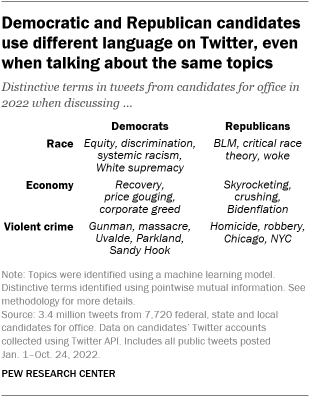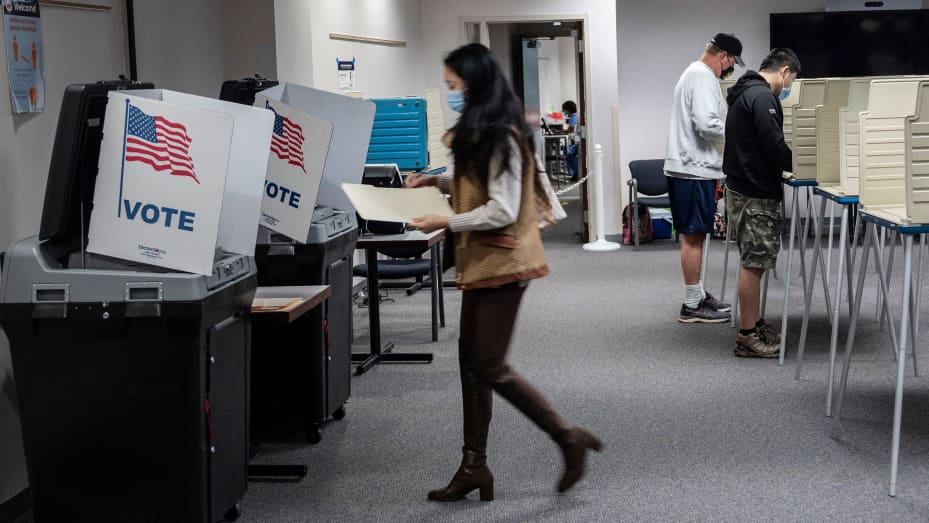As Election Day draws closer, candidates for office at the federal, state and local level are competing for the support of the voting public both online and off.
A new Pew Research Center analysis of more than 8,000 candidate Twitter accounts nationwide finds that the online campaign is in full swing.
Since the start of the year, candidates for office at all levels of government have shared almost 3.4 million tweets, including nearly 14,000 tweets per day in October.
Here are some of the key themes in how candidates have used Twitter during their 2022 campaigns:
One-in-five candidate tweets in 2022 have mentioned race, abortion, education or the economy. In public opinion polls, the economy has consistently ranked among the most important issues for registered voters ahead of Election Day.
But on Twitter, discussions by candidates around the country have focused on a number of issues – with race and ethnicity, abortion and education ranking alongside the economy among the key areas of focus.

Tweets mentioning these issues have accounted for roughly 20% of all political candidates’ posts in 2022 and have the highest average weekly ranking during the study period.
More than three-quarters of the candidates included in this analysis have tweeted at least once about all four of these issues in 2022.
Democrats have produced most of the candidate tweets focusing on issues like climate change and abortion, while Republicans have produced most of those focusing on immigration.
Across all three levels of government, Democratic candidates have produced the majority of all tweets regardless of topic (55% in total). Republican candidates have produced just 33% of all tweets. This pattern aligns with other Pew Research Center studies showing that Democrats and Democratic-leaning independents are more likely than Republicans and GOP leaners to use Twitter in general.

But in addition to these differences in basic tweeting behavior, there are partisan differences in how certain topics are being discussed by political candidates this year. So far in 2022, Democratic candidates have produced almost three-quarters of the tweets mentioning LGBTQ+ issues and identity and two-thirds or more of those mentioning environmental issues or abortion.
Conversely, Republican candidates have produced almost two-thirds of tweets about immigration – nearly double the GOP’s total share of candidate tweets overall. Republican candidates have also produced a large share of tweets mentioning topics like foreign policy (43%) and taxation (43%).
“Critical race theory” vs. “systemic racism”: Republicans and Democrats often use different language when talking about the same broad issue area. Republicans and Democrats often use very different language in their tweets, even when posting about the same general topic area. For example, in their tweets mentioning race, Republican candidates frequently reference the Black Lives Matter movement and use phrases such as “critical race theory” and “woke.” By contrast, Democrats’ tweets about race tend to be characterized by terms such as “equity,” “discrimination” or “systemic racism.”

When discussing the economy, Republicans and Democrats alike commonly reference inflation or the cost of living. However, Republicans often frame the issue with terms such as “crushing,” “skyrocketing” or “Bidenflation,” while Democrats commonly reference “recovery” and frame inflation with terms such as “price gouging” and “corporate greed.”
Although a recent survey by the Center found that Republican voters are much more likely than Democrats to consider violent crime to be a serious issue, candidates from both parties have tweeted about violent crime at similar rates throughout the year. However, Republican candidates’ tweets on crime are often characterized by terms such as “homicide” or “robbery” and make references to urban areas such as “Chicago” or “NYC.” By contrast, Democratic candidates often frame violent crime in the context of mass gun violence, especially in schools.
Republican candidates are more likely than Democrats to use negative language on Twitter – in general and for all major topics studied. When examining all candidate tweets in 2022, Republican candidates are more likely to take a negative tone: Some 33% of tweets from Republicans have used negative language, compared with 25% of tweets from Democrats. Republican candidates have been especially likely to use negative language when discussing topics such as immigration (54% of such tweets from Republicans were negative in tone), the economy (53%), the pandemic (51%), climate policy (46%) and LGBTQ+ issues (45%).
Indeed, none of the 16 substantive topics identified in this study saw a larger share of negative tweets from Democratic candidates than from Republican candidates.

Discussion of the economy has been a constant on Twitter during the 2022 campaign, but other topics have fluctuated over time. Candidate tweets mentioning the economy have been relatively consistent in terms of the overall volume of activity, with Democrats and Republicans trading places in terms of total tweets mentioning the economy from week to week. Similarly, immigration has been a relatively consistent theme, apart from a small increase coinciding with Florida Gov. Ron DeSantis’ decision to send migrants to Martha’s Vineyard in September.
Other topics have shifted in both overall volume and partisan composition over the course of the year. For instance, the Supreme Court’s decision to overturn Roe v. Wade and the shooting at Robb Elementary School in Uvalde, Texas, led to significant spikes in candidate tweets mentioning abortion and guns, respectively. And in each case, Democratic candidates have continued to tweet about these issues at substantially higher rates than Republicans.

After a brief period of interest in the early part of the year, candidate discussion of the COVID-19 pandemic has largely faded from sight. One of the defining events of recent years, the COVID-19 pandemic, has largely faded from the political conversation over the course of the 2022 campaign. Candidates for office have tweeted roughly 70,000 times about the pandemic since Jan. 1, but nearly half of those tweets (46%) were posted during the first three months of the year. From Sept. 1 through Oct. 24, candidates mentioned the pandemic in just under 11,000 tweets.
For registered voters, the pandemic also has slipped as a campaign issue. In an October survey by the Center, just 23% of voters said COVID-19 is very important to their vote this year – the lowest percentage among the 18 issues asked about in the survey and down from 33% in March.
As Election Day draws closer, partisan opposition has become more common in candidates’ tweets. As the campaign has progressed, candidates from both parties have more frequently referenced the opposing party – including specific prominent public officials – in their tweets. The overall volume of these tweets rose from roughly 5,000 per week in the early stages of the campaign to almost 10,000 per week by October. And when candidates have mentioned the opposing party, these references have been nearly universally negative. Some 95% of these tweets express disagreement, while fewer than 4% express some level of agreement.

In tweets mentioning the specific topics measured in this study, Republican candidates have mentioned Democrats in 20% of their tweets, while Democrats have mentioned Republicans in just 11% of theirs. Republican candidates have been especially likely to mention Democrats in tweets about topics such as foreign policy, taxes, climate and environment, the economy, immigration, and energy production. Meanwhile, Democrats have been especially likely to mention Republicans in tweets about the Jan. 6 hearings, tax policy, immigration and abortion rights.
Political candidates have mentioned Joe Biden and Donald Trump on Twitter as often as they have mentioned many issue areas. Even though 2022 is not a presidential election year, Joe Biden and Donald Trump each loom large on political candidates’ Twitter feeds. Some 4% of candidate tweets have mentioned either the current president or the former president – comparable to the share of candidate tweets that have mentioned the economy.
While Democratic and Republican candidates have mentioned Trump in a comparable share of their tweets this year, Republicans have been far more likely than Democrats to reference Biden or his administration (5% of tweets vs. 1.6% of tweets). Biden mentions are most common among Republican candidates at the federal level (7% of tweets from this group mention the Biden administration), but they are also fairly common among GOP candidates at the state and local levels as well (3% and 2% of tweets, respectively).
Mentions of bipartisanship are largely nonexistent on candidates’ Twitter accounts this year. Neither party’s candidates have had much to say about bipartisanship over the course of the year. Democrats are roughly three times as likely as Republicans to reference cooperation across the aisle, but even among Democratic candidates, this concept is mentioned in only 0.3% of tweets – versus just 0.1% of tweets by Republicans.
Candidates in California have contributed heavily to Twitter discussions about climate change, while those in Texas have contributed heavily to discussions about immigration. Candidates from California posted 8% of all candidate tweets in the Center’s analysis, but nearly 18% of tweets mentioning climate change or environmental issues. Likewise, candidates from Texas accounted for nearly 10% of all tweets, but almost 20% of tweets that mentioned immigration during the campaign.
Nearly two-thirds of all tweets from candidates running for office in 2022 did not mention any of the 16 issues included in this analysis. Most of the Twitter conversation among political candidates this year has focused on something other than the 16 substantive topics the Center classified in this analysis. Much of this content appears to be less about discussing substantive issues and more about raising general support and awareness for the candidates and their campaigns.






